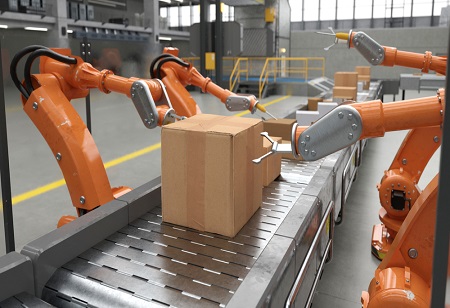
With the industrial revolution, the manufacturing sector has undergone significant changes & one of these were the introduction of robots & automation in the industry. They were introduced to the market with an aim to optimize productivity & decreasing operating costs. However, today robots are highly programmable as well as controllable to perform complex activities by leveraging AI. Keep reading to understand the numerous roles robotics plays in manufacturing, and how it has impacted the industry. Robots collaborate with human workers/cobots on almost all kinds of tasks, today. Robotics in the manufacturing industry is implemented for not just cutting down repeated tasks but for streamlining the assembly workflow. Some of the important applications of robotics in the manufacturing industry include:
Material Handling
Robots today are used for handling a continually expanding range of materials that are either stable or hazardous. This technique also decreases the risks of injury to human employees as the robots will never become weary while carrying out their fundamental jobs. These can now do more jobs and this means employees can be redeployed to do more complex processes to increase employee satisfaction.
Picking, packing, & palletizing
After the product has been built/manufactured, picking & packaging robots can carry out various types of tasks. These can quickly choose individual parts, and pack them appropriately as well as palletize them. Robotic picking & packing can optimize your production with accuracy as they can choose & pack items even more quickly.
Part transfer
Since heavy materials are moved from one place to another by using part transfer robots, it is not just risky, but also challenging, time-consuming, as well as demanding for labourers to carry huge, heavy pieces. Furthermore, part transfer robots render a secure way for keeping employees out of dangerous situations & injury-free.
Machine Loading
Robots which are used in the process of loading & unloading machinery are implemented in manufacturing line tasks that involve the loading & unloading of components. It would become challenging as well as dangerous at times for human employees to load & unload parts from a machine. Robotic machine loading will now enhance the output, safeguard employees from potential harm & eliminate tiresome, & repetitive labor.
Assembly
While it takes a lot of time & effort for putting product pieces together, mistakes in judgement, boredom, as well as other uncontrolled variables can easily derail the process. Therefore, a robot can take the place of such a system and can streamlining the procedure & drastically reduce the likelihood of any error. In addition, this allows the assembly process's human components to concentrate on quality.
Welding
Heat & pressure are used for putting together the metal components, and it is a risky operation which demands flawless accuracy. Although the manufacturing process might be hampered, the metal component can be ruined & major harm can take place right from the slightest welding error and owing to these factors, robots are being used for welding tasks increasingly.
Painting
Industrial paint robots are often implemented in the automobile industry for uniformly painting components & equipment without leaving any paint drips or markings. These are accurate, & are used to apply the proper quantity to every piece of machinery. Industrial painting robots are manufactured or built in such a way that should be thin enough to go into nooks & crannies which would be challenging & time-consuming for human painters to access.
Dispensing
Dispensing robots are kept in a strategic location close to the product route for procedures which call for the application of glue or paint to a surface. This is another type of repetitive task where robots can do it even more accurately & efficiently compared to a human worker.
Processing
Before selling some of the products they have to go through a specific form of processing like carving, polishing, or even sawing. Robots perform these tasks to varying degrees of autonomy, based on the difficulty of the process & the capabilities of the robot. Automation & robotics have become highly imperative for businesses in order to reduce human contact & stay competitive. Robots in manufacturing account for a major part of robotic spending & have benefited various effects of the pandemic. Conventionally, industrial robots work individually from humans as well as other machines. But, today owing to advances in technology, collaborative robots can be integrated into the workforce & they can work along with humans without safety fencing. Researchers are finding numerous ways for making robots even more collaborative & perform end-to-end jobs. Furthermore, with the advent of AI, robots in manufacturing industry have started collecting data & are helping manufacturers in making better decisions for the future & help them in their manufacturing process. Robots have already begun to change the dimension of the industries.

